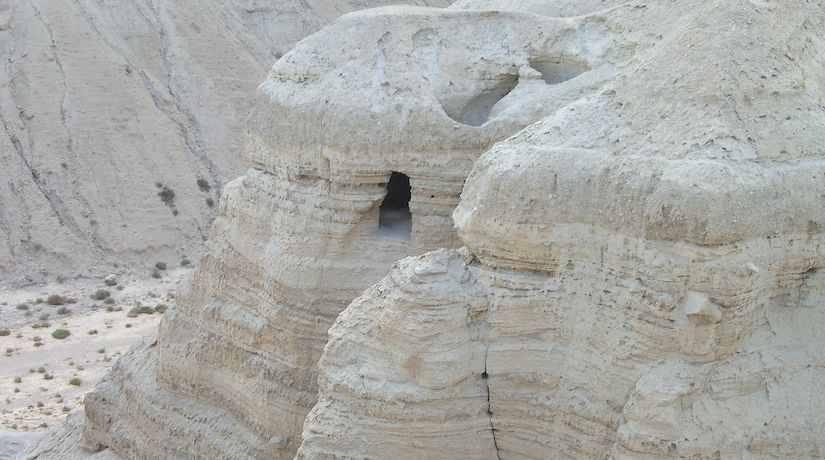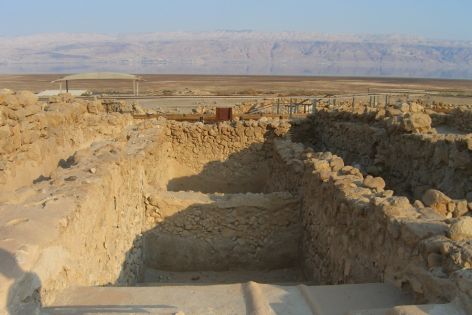The ancient Dead Sea Scrolls found in caves in the desert help show that the Bible has been preserved carefully and accurately—just as God wanted!

The Dead Sea Scrolls were found in caves at Qumran (photo by David Treybig).
The Dead Sea Scrolls have been described as the most important archaeological discovery of the 20th century. They serve to confirm the accuracy with which the Bible has been preserved for our benefit.
Finding the Dead Sea Scrolls
The name Dead Sea Scrolls is a bit of a misnomer because they were not retrieved from the Dead Sea but from a number of caves about a mile from the northwest shore of the Dead Sea. And the material found includes more than scrolls. Archaeologists discovered a large volume of artifacts consisting of scrolls and a variety of fragments containing ancient biblical texts and religious literature. This find soon became known as the greatest ancient manuscript treasure ever discovered.
While the details of the actual discovery are somewhat vague, it has been generally accepted that a Bedouin made the first discovery in 1947 in the area of Qumran, which is 1,300 feet (almost 400 meters) below sea level and about 12 miles (19 kilometers) from the ancient city of Jericho and about an equal distance from Jerusalem. The name Qumran is a reference to a “stone ruin.”
While looking for a lost goat, the Bedouin discovered a cave, now generally referred to as Cave 1. (The caves have been code-named 1Q, 2Q, etc.) Along with a variety of fragments, this cave contained the first of the Dead Sea Scrolls. This original discovery was a sensational event by itself, but during the excavations in the area (begun in earnest in 1951 and completed in 1956) an additional 10 caves and many more artifacts were discovered!
11 caves and more than 100,000 fragments
Of the 11 caves, the first and fourth caves are considered to be the most important. Caves 1 and 11 were the only caves that produced relatively intact manuscripts.
With the exception of the book of Esther, fragments of every book of the Old Testament were discovered. Scholars considered the absence of fragments of the book of Esther a little surprising, especially because there is a text from Cave 4 that quotes from the book of Esther, which established the fact that those who deposited the scrolls must have been familiar with the book.
The discoveries consisted of 220 scrolls out of more than 1,000 documents. Altogether there were in excess of 100,000 fragments.
The Dead Sea Scrolls include the oldest group of Old Testament manuscripts ever located.
However, by far the majority of these discoveries turned out to be nonbiblical Jewish literature. For instance, of the 584 fragmentary texts that were located in Cave 4Q, only 127 were biblical. Among the nonbiblical writings were commentaries on the Old Testament, interpretations and paraphrases on the Law and a number of rule books for the general conduct of the community of Essenes that lived in the area from 200 B.C. to A.D. 68.
The so-called Temple Scroll, which was found in Cave 11, is over 8 meters in length (26.7 feet) and is the longest scroll found.
The Essenes
The Essenes are considered to have been the most likely authors of the scrolls, although some scholars believe that the scrolls were written in Jerusalem or elsewhere and may have been brought to Qumran.
Excavations at Qumran with the Dead Sea in the background (photo by David Treybig).
All members of the community were Jews who daily referred to the Scriptures, although they had renounced Jerusalem Judaism and its official class structure. Archaeological and historical evidence shows that the community was established in the second half of the second century B.C. The habitations, together with the extensive libraries, were abandoned when the Romans invaded the area in A.D. 68. The fate of the community after the Romans invaded is unknown.
The texts and the scribes
The majority of the scrolls were made of leather parchment or papyrus, although one scroll was made of copper. The leather scrolls were made of carefully prepared leather pieces sewn together and carefully scraped. The Isaiah scroll comprises 17 leaves that were carefully sewn together to make a roll about 7.5 meters (24 feet) long. The scribe took pains to make both horizontal and vertical lines on the leather to serve as guides for the lines and columns and to achieve neatness.
It is interesting to note that the occupation of scribe is mentioned 48 times in the Old Testament. Scribes performed an important function, and they were highly skilled. Some of the work of a scribe is recorded in Jeremiah 36. Jeremiah had been commanded by God to write on a scroll as recorded in verse 2, and in verse 4 Jeremiah instructs his secretary Baruch to write on “a scroll of a book” all that God had told him to record. Verse 23 records that the scroll was read in columns.
The Isaiah scroll helps confirm the accuracy of the Bible
One of the most important biblical discoveries was the scroll containing the complete book of the prophet Isaiah, which has since become known as the Great Isaiah Scroll. This Isaiah scroll predates the oldest preserved copies of the so-called Masoretic Text of the book of Isaiah by more than a thousand years.
The Great Isaiah Scroll.
Although there were initial concerns by scholars that the ancient Isaiah scroll would show considerable variations compared with the Masoretic Text of the Old Testament, their concerns vanished after it was discovered that there were only a small number of minor and inconsequential differences between the two texts. Even though the scroll was more than a thousand years older than the Masoretic Text, the authenticity of the scroll proved how few minor changes had occurred during this lengthy period.
Also important in confirming the accuracy of the Bible was the discovery of more than 20 fragments containing quotations and sections of every chapter of the book of Deuteronomy. Deuteronomy is one of the most noteworthy books of the Old Testament. Its authority and influence can be observed in the books of Samuel, Hosea and Jeremiah and in the New Testament by Jesus Christ.
For instance, when Jesus was tempted by Satan, as recorded in Matthew 4:1-11, He countered Satan by quoting Deuteronomy 8:3 and 6:13 and 16. In Matthew 22:36 when Jesus was asked by the lawyer, “Teacher, which is the great commandment in the law?” Jesus responded by quoting Deuteronomy 6:5.
Scientific study of the scrolls
The discovery of the Dead Sea Scrolls was only the first step in the process of interpreting and evaluating what had been discovered. That work continues today, although fewer scholars are involved now, working in more specialized ways.
The experts who study the ancient writings of the Dead Sea Scrolls are referred to as paleographers. They painstakingly scrutinize enlarged photographs of the various manuscripts and fragments.
Scholars also had to deal with translating the text on the scrolls and the numerous fragments. While most of the scrolls and fragments were written in the Hebrew language, a smaller number of manuscripts were written in Greek and some were written in Aramaic, a sister language of Hebrew.
Many of the Dead Sea Scrolls are at the Shrine of the Book at the Israel Museum in Jerusalem.
The experts have recently completed part of the project of making digital images of all of the scrolls and fragments, and it is now possible for scholars anywhere in the world to view accurate images of the originals instead of reading someone else’s translation. According to the Israel Museum website, five of the scrolls are now available for viewing in digital format.
In 1962 the first edition of The Dead Sea Scrolls in English was published by the British scholar and author Geza Vermes. This was followed by several revisions he completed, including the 1997 edition titled The Complete Dead Sea Scrolls in English. These make it possible for the nonexpert to read the actual texts of the scrolls in English rather than having to rely on books written about them.
Preserved for us
Many authors have described the discovery of the Dead Sea Scrolls as the most important discovery in many centuries. The Dead Sea Scrolls have enhanced our knowledge and understanding of both Judaism and Christianity.
We can be grateful that the discovery of the Dead Sea Scrolls can assist us in understanding the Scriptures better. As Hershel Shanks, founder and editor of Biblical Archaeology Review, stated: “There is not a single question about the period from the third century B.C. to the second century A.D. that can be explored without asking whether the scrolls shed some light on the matter” (The Mystery and Meaning of the Dead Sea Scrolls, 1998, p. 199).
In addition to that, the Dead Sea Scrolls confirm that the text of our present Hebrew Bible, which has been copied numerous times, is still essentially the same as the text discovered on scrolls that had been hidden from scrutiny for nearly 2,000 years. God has preserved His Bible carefully and accurately to serve as our guide to life.
Read more about this in the articles in the sections on “Is the Bible True?” and “Bible Study.”




